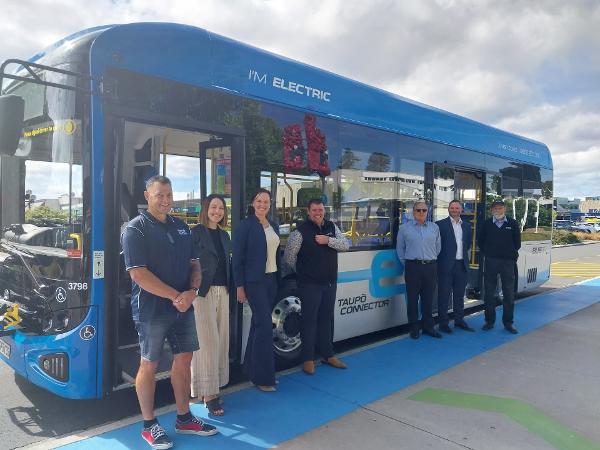New EV kicks off Waikato bus network electrification

From Monday, 4 December, Waikato’s first electric bus takes to the streets of Taupō replacing the current diesel vehicle, which has been a mainstay of the Waikato public bus system for years. The new Taupō Connector will be cleaner, quieter and emission free: a sign of things to come for the rest of the public transport network.
Waikato Regional and Taupō District Councils officially launched the new bus at an event on Friday (today). It carries up to 56 passengers at a time: 27 seated, 27 standing and two in wheelchairs. On request, the bus can tilt towards the curb and extend a ramp to provide easier access for passengers.
Tranzit Coachlines operates the buses, which are designed for efficiency. The 120kW charger at Tranzit’s Taupō depot takes two hours to charge the battery and uses a smart charging system that takes advantage of off-peak power prices. Waka Kotahi reports that electric bus trials in Auckland reduced operating costs by 70 to 85 per cent compared to diesel vehicles running the same route.
Passengers can be confident that these cost efficiencies won’t compromise reliability. The 281kWh on-board battery powers the engine and in-built regeneration technology recharges it when the bus brakes, meaning the bus can travel for approximately 300km around town on a single charge, ideal for a service like the Taupō Connector.
The Connector travels for about 270km each weekday, making seven return loops (six on the weekend) between Wharewaka in the northwest of town and Nukuhau in the south. There’s even enough power for passengers to charge their phones through the USB ports on board, and drivers can top up at the depot in off-peak times if needed.
Mich’eal Downard, Waikato Regional Councillor for Taupō-Rotorua and chair of the Regional Transport Committee, says these zero-emission buses are critical for achieving Waikato’s public transport objective to make services net carbon neutral from 2025 to 2050: “EVs are a game changer for reducing emissions across our network, so this is a big deal and I’m very happy that it happens to be in Taupō.”
Waikato’s public transport network covers approximately 730km of roads outside of Hamilton City and daily passenger numbers this year are up 28.4 per cent on 2022. The network carried an average of 7948 passengers a day last year but was carrying 10,208 at the end of October 2023.
The regional council’s public transport manager, Trudi Knight, says continual improvements to services and options are making a difference: “The great thing about the increasing passenger numbers is we’ve done it without increasing the average number of bus trips each day. We had 760 last year and 758 this year.”
She says, “On an average day, we’re taking the equivalent of 8876 car trips off the road. Obviously, this is great for reducing emissions but every EV bus we can add to our network makes it even cleaner and more efficient.”
People can see for themselves and ride Taupō’ new electric service for free during its first week, or any time in December by grabbing one of 250 complimentary tickets available at the Taupō Customer and Visitor Information Centre.
